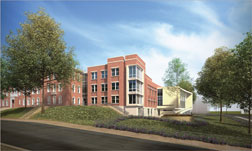|
The following alternatives were chosen to compare cost and energy impact to the current design. Also, the alternatives were chosen for educational interest and benefit. The proposed investigations are not meant to imply faults in the original design, but are presented for the educational value.
Depth
The proposed alternative that will be investigated is implementing a water-cooled VRF condenser looped with a heat exchanger to a geothermal heat pump. This will change the VRF condensers from air-cooled to water–cooled. A heat exchanger will transfer the loads between the three condensing units and the geothermal system. A closed loop geothermal system has antifreeze filled pipes that transfer loads between the building and the earth. The pipes will be in vertical wells to exchange heat with the constant temperature of the earth. The earth temperature becomes constant from 20 ft. to 30 ft. below the surface depending on the area.
The alternative design will have an impact on the initial cost and energy consumption of the mechanical system. Water-cooled systems have higher initial cost, but are more energy efficient than air-cooled systems. The heat transfer properties of water are much better than those of air. The water-cooled has constant performance whereas air-cooled the performance is dependent on the ambient air temperature. Also, the installation of the geothermal system will be costly, but the system will be using a basically free energy sink, the earth.
Construction
The construction of the geothermal system will alter the coordination, schedule, cost and site layout of the construction management team. An analysis of the impacts on coordination, schedule and cost will be performed. The geothermal system additional cost may include materials, installation, controls and more. The schedule may or may out be affected depending on the site coordination. These impacts will be investigated and evaluated throughout the construction process.
Acoustics
The spaces served by the packaged roof top units, cafeteria and multi-purpose room, have not been acoustically addressed. These spaces are served by untreated ducts directly from the roof top units and may produce high background noise levels. The high ceiling height and surface materials of the spaces may allow for poor acoustical characteristics like reverberation time, absorption, and diffraction. An assessment of the spaces will be performed using software, and alternative solutions will be evaluated.
Masters Coursework
The integration of the geothermal heat pump to the VRF system will involve knowledge gained from several master courses. Information learned in AE 557 (Centralized Cooling Production and Distribution Systems) will be used in the design and investigation of water-cooled condensers and geothermal systems. AE 552 (Indoor Air Quality) content was used during the evaluation of current ventilation and mechanical systems. AE 557 (Centralized Heating Production and Distribution Systems) content will help in the energy consumption and life-cycle cost analysis. |
